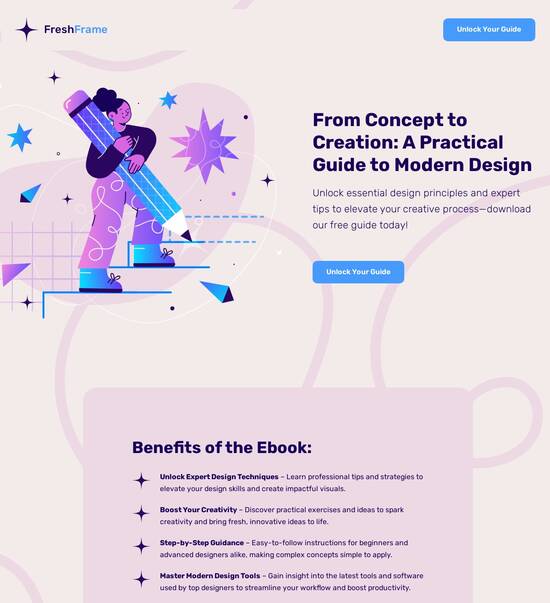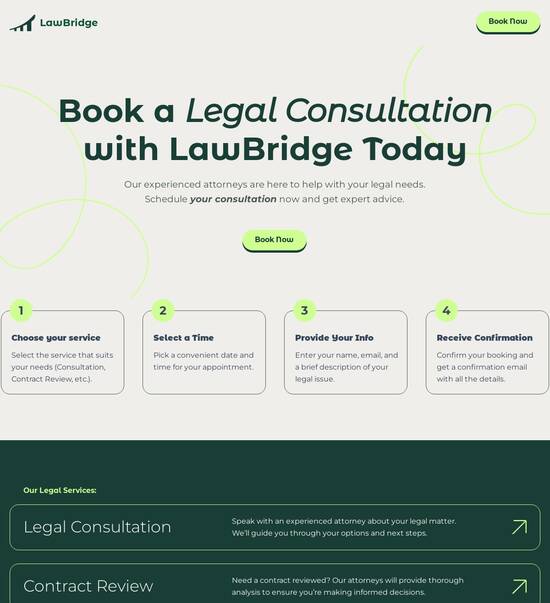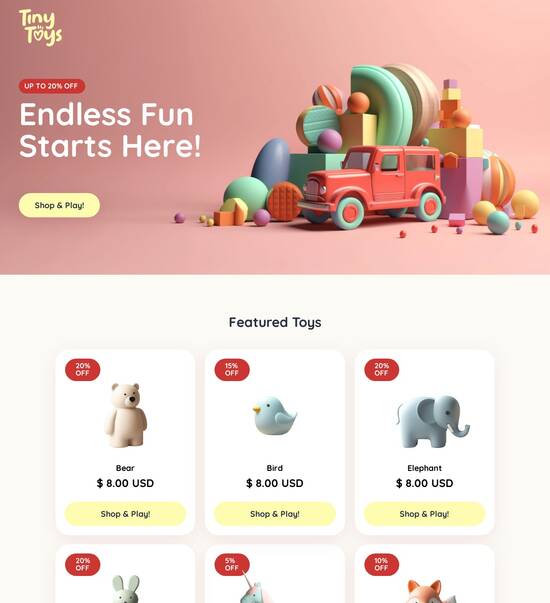
HTML/CSS optimized upcoming events page template
Explore Similar TemplatesAbout template
Supercharge your upcoming events page with HTML/CSS for outstanding performance! Learn more today.
Recommended templates

Easy to build without coding
With the intuitive drag-and-drop builder, anyone on your team can create high-converting pages without any knowledge of code or design. Make enhancements to your landing page with custom widgets using Javascript, HTML/CSS, or third-party scripts.

Multiple layouts for any industry and goal
Select from 500+ landing page layouts built to boost conversions across industry-specific scenarios. Customize them by adjusting fonts, adding images, and generating on-brand content with the AI assistant. Quickly scale with Instablocks® and Global Blocks that you can save, reuse, and update globally.

Loads fast and looks polished on any device
Every template is responsive, which means they present professionally on any device and load blazingly fast with our Thor Render Engine. You can also power them up with Google AMP technology to deliver an unparalleled mobile experience and drive higher conversions.

Robust analytics & experimentation
Get real-time updates and reporting across all your devices, showing the number of visitors, conversions, cost-per-visitor, and cost-per-lead. Launch AI-powered experiments, run A/B tests, and use heatmaps to analyze user behavior, then optimize your landing page to maximize conversions.







Easy to build without coding
With the intuitive drag-and-drop builder, anyone on your team can create high-converting pages without any knowledge of code or design. Make enhancements to your landing page with custom widgets using Javascript, HTML/CSS, or third-party scripts.
Multiple layouts for any industry and goal
Select from 500+ landing page layouts built to boost conversions across industry-specific scenarios. Customize them by adjusting fonts, adding images, and generating on-brand content with the AI assistant. Quickly scale with Instablocks® and Global Blocks that you can save, reuse, and update globally.
Loads fast and looks polished on any device
Every template is responsive, which means they present professionally on any device and load blazingly fast with our Thor Render Engine.
Robust analytics & experimentation
Get real-time updates and reporting across all your devices, showing the number of visitors, conversions, cost-per-visitor, and cost-per-lead. Launch AI-powered experiments, run A/B tests, and use heatmaps to analyze user behavior, then optimize your landing page to maximize conversions.
All the features you need to build lead-generating landing pages
Explore more featuresLearn how to build top-performing landing pages for any goal
FAQs
Leading the way in building high-performing landing pages





Master the art of creating high-converting landing pages with Instapage
Building high-converting landing pages is critical for digital marketing success. Instapage empowers marketers to quickly launch pages designed to maximize lead capture and conversion rates. With over 100 customizable templates, you can create tailored content that resonates with your unique audience across various verticals including business services, education, and technology.
Why choose Instapage for your landing pages?
Choosing the right platform can make a significant difference in your campaign effectiveness. Instapage stands out as a premier conversion rate optimization (CRO) tool that not only allows easy creation but also provides advanced optimization features.
- Access to 100+ high-converting templates: Save time and streamline development with ready-to-use designs that cater to various industries.
- Built-in A/B testing: Instapage enables easy experimentation with your landing pages, ensuring that you're always optimizing for the best performance.
- Dynamic text replacement: Personalize your landing pages to reflect the interests and needs of different audience segments effectively.
Step 1: Choose the right template
Start by selecting a landing page template that aligns with your campaign goals. Focus on templates tailored for your specific audience within your sector, whether it’s education or financial services.
Step 2: Customize your content
To ensure maximum engagement, utilize the drag-and-drop editor to tailor your content. Consider these points:
- Incorporate strong calls to action: Guide users effectively through clear and compelling language.
- Use compelling imagery: Leverage visuals that resonate with your brand identity and audience preferences.
- Adjust colors and fonts: Consistency with your branding will enhance recognition and trust.
Step 3: Optimize for conversions
Leverage optimization tools to ensure your landing page reaches its full potential. Focus on the following:
- Implement heatmaps: Analyze user interactions on your page to identify areas needing improvement.
- Conduct A/B tests: Regular testing can highlight what resonates best with your audience.
- Utilize real-time analytics: Measure performance metrics to understand visitor behavior and adjust strategies accordingly.
Instapage simplifies the process of creating high-quality landing pages. Through user-friendly tools and analytics, you can efficiently improve your digital marketing efforts.
Ready to supercharge your marketing campaigns? Start using Instapage today to create landing pages that drive results and optimize your conversion rates.
HTML/CSS optimized upcoming events page template
Historical context of HTML and CSS in event page design
HTML, or Hypertext Markup Language, has its roots in the early days of the internet when it was developed by Tim Berners-Lee in the late 1980s. Initially, HTML comprised a small set of tags that catered primarily to text formatting. Since then, it has undergone significant transformations, leading to the introduction of HTML5, which now supports multimedia elements, richer semantics, and interactive applications. With growing web standards, HTML has evolved to allow more complex structures for web content, making it the backbone of web design, especially for pages displaying upcoming events.
CSS, or Cascading Style Sheets, emerged alongside HTML as a solution to style web pages without cluttering HTML code with presentations. Over time, CSS developed from essential style definitions to a robust language capable of advanced layout techniques. CSS3 brought forth features like flexbox and grid layouts, making it easier to design responsive pages that adapt across various devices—a critical factor in today's mobile-driven world.
The significance of an optimized events page template
Events are pivotal for businesses and community engagements as they facilitate connection and brand loyalty. Recent statistics indicate that nearly 70% of attendees are likely to engage with a brand after participating in an event hosted online. Therefore, having a well-designed events page is crucial for maximizing registration and enhancing user experience. A tailored events page not only informs prospective attendees about event details but also serves as a compelling advertisement for your brand.
An optimized events page template should incorporate essential features to streamline the user experience. Key elements include:
Event title and description to catch interest.
Clear date and time to avoid confusion.
Location details with integration of maps for easy navigation.
A prominently placed registration button or RSVP option.
Incorporating multimedia elements such as images, videos, and social sharing options can further engage visitors while providing them with intuitive access to event details. These features together create a holistic experience that increases the likelihood of attendance.
Designing an effective events page layout
When considering the layout of an events page, understanding core design principles is paramount. User Interface (UI) and User Experience (UX) play significant roles in determining how visitors interact with the page. Use of color schemes that complement your brand identity and typography choices that are easy to read can enhance the overall perception of the events listing.
Moreover, a well-structured functional events page should include the following sections:
Hero section with eye-catching graphics that draw immediate attention.
Event details section providing succinct information.
A countdown timer to create urgency for registration.
Testimonials from past attendees to build trust.
FAQ section addressing common inquiries from potential attendees.
Balancing aesthetic appeal with functional layout ensures that users can navigate effortlessly while quickly obtaining the information they need.
Innovations in HTML/CSS for events pages
Recent advances in HTML and CSS have propelled responsive design in event page development. The implementation of HTML5 and CSS3 frameworks enables pages to adapt seamlessly across devices, providing a consistent experience for users regardless of their platform. This flexibility allows potential attendees to access event information from smartphones, tablets, or desktop computers with ease, mitigating bounce rates.
Moreover, integrating interactive elements has proven beneficial in engaging users. Consider adding:
An event countdown to build excitement.
Dynamic maps that offer real-time navigation assistance.
Simple registration forms designed for ease of use.
Additionally, CSS transitions and animations can create visually appealing interactions that keep users interested, encouraging them to learn more about the upcoming events.
Key trends influencing events page design
Design trends in event management are continually evolving. Currently, a minimalist approach stands out, emphasizing simplicity and clarity. This design style not only reduces visual noise but also enhances user engagement, allowing visitors to focus on the critical information without distractions.
Moreover, integrating social media feeds and providing live updates fosters a sense of community around events. Users appreciate being able to interact with event content and contribute their thoughts, which can foster a deeper connection with the brand.
For optimal visibility in search results, SEO considerations for event pages need to be addressed. Important practices include:
Implementing meta tags to enhance page descriptions.
Using alt attributes for images to improve accessibility.
Establishing a clear content hierarchy to aid indexing.
Furthermore, utilizing structured data can significantly boost your events page's visibility, allowing search engines to present detailed information about your events in search results.
Case studies: Successful event pages in action
A multitude of successful event pages exists across various industries. Analyzing industry-leading event pages can yield insights into effective design elements and features that drive higher conversion rates. For instance, pages that integrate compelling visuals, streamlined registration processes, and social proof through testimonials typically see increased attendance.
Nevertheless, not all event pages meet the mark. Several non-optimal designs become barriers to success due to cluttered layouts, vague information, and inefficient navigation. Observing these cases helps identify common pitfalls, allowing designers to avoid similar mistakes in their projects. To enhance usability, employing A/B testing and visitor feedback loops is essential. This process helps refine designs based on real user experiences, tailoring elements to meet audience needs.
Leveraging tools for building optimized events pages
Thanks to advancements in web development, numerous page builders are available to simplify the creation of dynamic events pages. These tools provide pre-designed templates and a variety of customization options, drastically reducing the time required to develop an event page. Utilizing page builders like Instapage allows marketers to create tailored event pages rapidly and without the need for extensive coding skills.
When comparing popular page builder tools, aspects such as ease of use, customization capabilities, and integration with other tools should be considered. Features like drag-and-drop functionality and preset functionality templates facilitate ease of design, making it accessible for users at all skill levels.
Editing and personalizing HTML/CSS in templates is another valuable approach for marketers. Best practices include:
Keeping the code clean and organized to ensure maintainability.
Utilizing libraries and frameworks to enhance the template's functionality without reinventing the wheel.
These strategies collectively enhance the final user experience and engagement on the events page.
Measuring the impact of your events page
To assess the effectiveness of your events page, monitoring visitor behavior and conversions is crucial. Key performance indicators (KPIs) can include registration numbers, bounce rates, and average time spent on the page. Tools such as Google Analytics can provide valuable insights, enabling marketers to understand how users interact with their event pages, identify pain points, and adjust accordingly.
Additionally, implementing feedback mechanisms can contribute significantly to continuous improvement. Gathering visitor feedback post-event through surveys or comment sections allows marketers to identify areas for enhancement. The insights gained can be utilized in future events, leading to a more personalized approach to user needs and preferences.
Future-proofing your events page design
To stay relevant in the evolving landscape of online event marketing, it's vital to anticipate trends. Analyzing patterns in user behavior, technology advancements, and social media interactions will help marketers adapt future event pages to meet audience expectations. For example, rising interest in virtual and hybrid events may necessitate unique design elements that cater specifically to showcasing these formats.
Furthermore, the role of artificial intelligence (AI) in event marketing continues to gain traction. Utilizing AI-driven features can lead to personalized user experiences that effectively target specific audience segments. Case studies have demonstrated successful implementations where AI tools enhance elements such as recommendations based on user behavior or content optimization tailored to visitor interest. These innovative approaches are likely to define the next chapter in event marketing.
Ready to skyrocket conversions?
Supercharge your ad campaigns with high-performing landing pages
Get started














